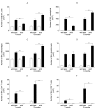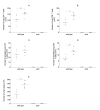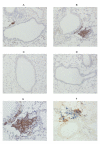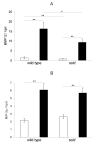Cigarette smoke-induced pulmonary emphysema in scid-mice. Is the acquired immune system required?
- PMID: 16359546
- PMCID: PMC1334210
- DOI: 10.1186/1465-9921-6-147
Cigarette smoke-induced pulmonary emphysema in scid-mice. Is the acquired immune system required?
Abstract
Background: Chronic obstructive pulmonary disease is associated with a chronic inflammatory response of the host to chronic exposure to inhaled toxic gases and particles. Although inflammatory cells of both the innate and adaptive immune system infiltrate the lungs in pulmonary emphysema and form lymphoid follicles around the small airways, the exact role of the acquired immune system in the pathogenesis of emphysema is not known.
Methods: In this study, wild type Balb/c mice and immunodeficient scid mice--which lack functional B- and T-cells--were exposed to mainstream cigarette smoke (CS) for 5 weeks or 6 months.
Results: Subacute CS-exposure for 5 weeks significantly increased innate inflammatory cells (neutrophils, macrophages and dendritic cells) in the bronchoalveolar lavage (BAL) fluid of wild type mice and scid mice, which correlated with the CS-induced upregulation of the chemokines Monocyte Chemotactic Protein-1, Macrophage Inflammatory Protein-3alpha and KC (= mouse Interleukin-8). Chronic CS-exposure for 6 months significantly increased the number of neutrophils, macrophages, dendritic cells, CD4+ and CD8+ T-lymphocytes in BAL fluid and lungs of wild type mice compared to air-exposed littermates, and augmented the size and number of peribronchial lymphoid follicles. In contrast, neither B-lymphocytes, nor T-lymphocytes, nor lymphoid follicles could be discerned in the lungs of air- or CS-exposed scid mice. Importantly, chronic CS-exposure induced pulmonary emphysema in both wild type animals and scid mice, as evidenced by a significant increase in the mean linear intercept and the destructive index of CS-exposed versus air-exposed animals. The CS-induced emphysema was associated with increased mRNA expression of matrix metalloproteinase-12 in the lungs and increased protein levels of Tumor Necrosis Factor-alpha in the BAL fluid of CS-exposed Balb/c and scid mice compared to air-exposed littermates.
Conclusion: This study suggests that the adaptive immune system is not required per se to develop pulmonary emphysema in response to chronic CS-exposure, since emphysema can be induced in scid mice, which lack lymphoid follicles as well as functional B- and T-cells.
Figures







References
-
- Pauwels RA, Buist AS, Calverley PM, Jenkins CR, Hurd SS. Global strategy for the diagnosis, management, and prevention of chronic obstructive pulmonary disease. NHLBI/WHO Global Initiative for Chronic Obstructive Lung Disease (GOLD) Workshop summary. Am J Respir Crit Care Med. 2001;163:1256–1276. - PubMed
-
- Barnes PJ, Shapiro SD, Pauwels RA. Chronic obstructive pulmonary disease: molecular and cellular mechanisms. Eur Respir J. 2003;22:672–688. - PubMed
Publication types
MeSH terms
Substances
LinkOut - more resources
Full Text Sources
Other Literature Sources
Medical
Research Materials

